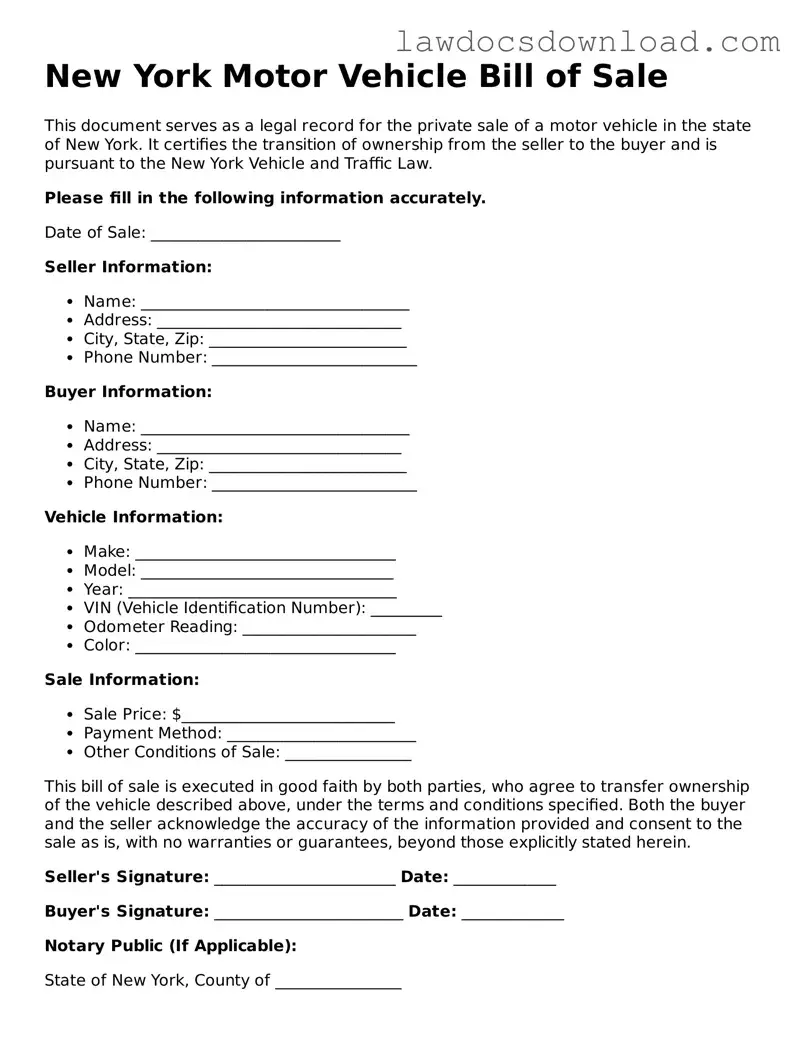The New York Motor Vehicle Bill of Sale is akin to a Warranty Deed in several ways. Both documents serve as formal agreements that transfer ownership from one party to another. In a Warranty Deed, the seller guarantees they have the right to sell the property and that it's free from any liens or claims. Similarly, a Bill of Sale for a motor vehicle assures the buyer that the seller holds clear title to the vehicle and has the right to sell it, providing a legal foundation for the transfer of ownership.
Comparable to a Promissory Note, the Motor Vehicle Bill of Sale sometimes acts as a pledge, especially if the purchase includes terms of payment over time. A Promissory Note outlines the borrower's promise to pay back a debt under specific conditions. When a Bill of Sale includes terms that allow the buyer to pay in installments, it incorporates elements of a Promissory Note, specifying the amount due and the repayment schedule.
A Quitclaim Deed, much like the Bill of Sale, offers a simplified process for transferring interest in property, albeit typically used for real estate. The Quitclaim Deed does not guarantee a clear title; it merely transfers the seller's interest in the property to the buyer. A Motor Vehicle Bill of Sale similarly transfers the seller’s interest in the vehicle to the buyer but often assures the buyer of the seller’s rightful ownership and that the title is clean.
An Employment Contract shares similarities with the Motor Vehicle Bill of Sale through its detailed list of terms and conditions agreed upon by two parties. In an Employment Contract, these terms encompass job responsibilities, compensation, and conditions of employment. The Motor Vehicle Bill of Sale details the vehicle's sale conditions, including sale price, descriptions of the vehicle, and warranties, thereby laying down the terms of agreement for the sale and purchase.
A Lease Agreement, used for renting properties, shares commonalities with a Motor Vehicle Bill of Sale in terms of specifying terms between two parties. While a Lease Agreement covers the rental of property, detailing the duration, payment, and use conditions, the Bill of Sale outlines the terms of sale for a vehicle, including payment details and delivery of the vehicle.
A Loan Agreement resembles a Motor Vehicle Bill of Sale when a vehicle purchase is financed. The Loan Agreement specifies the terms under which the lender provides funds to the borrower, including repayment schedule, interest rate, and collateral, if applicable. When a Bill of Sale for a motor vehicle includes financing terms, it similarly specifies payment details, acting as evidence of the agreement between the buyer and the seller concerning the purchase on credit.
Lastly, the General Contract for Services parallels the Motor Vehicle Bill of Sale in establishing a clear agreement between parties for the provision of services, with specified terms and conditions. Just as the General Contract outlines the nature of services, deliverables, payment terms, and duration, the Bill of Sale specifies the details of the vehicle transaction, ensuring both parties have a mutual understanding of the agreement's specifics.
